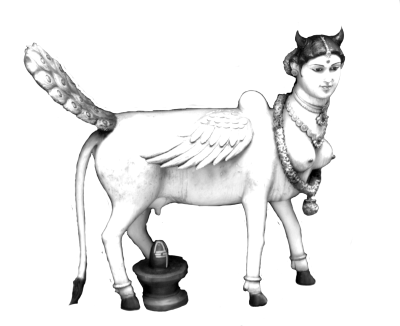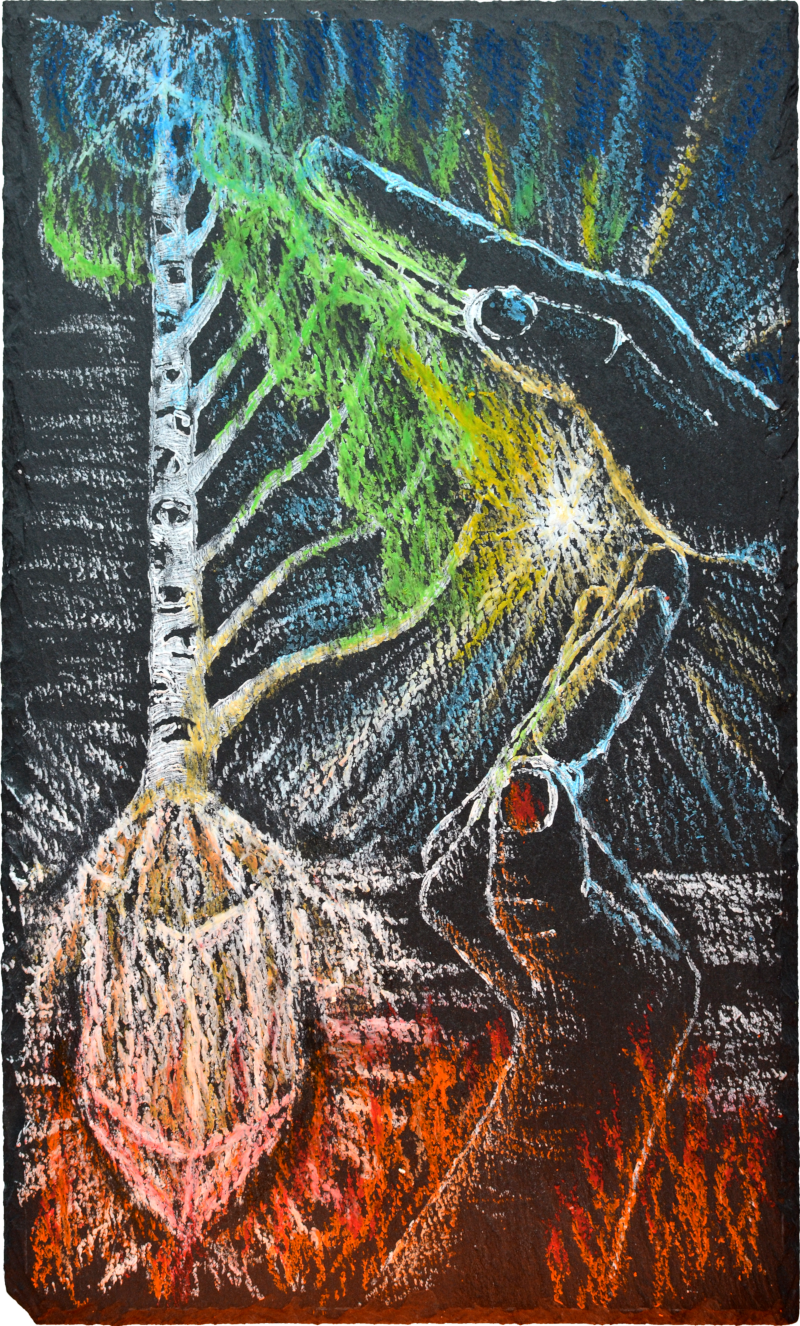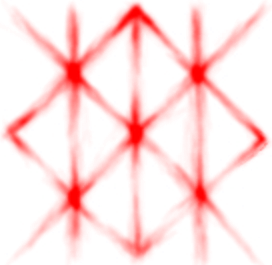18. The Tree of Light
Laguz Rune
We were talking about the Water already, but Laguz rune is not "just" the Water. The Water is a primordial force, that existed before creation. But Laguz comes to the scene only in the middle of the alchemical process. This rune may look simple, but it's very very deep.
In various versions and languages, it means lake, ocean, sea, water, and waterfall.
As you see it has a vertical bar, and it's also a central bar of the Stone.
At the bottom, it starts at the level of Earth, where we already have a Crystal. Like snowy mountain peaks connecting the earth to the sky, the sharp tip of the Crystal pierces the horizon of Emptiness. The beam of Light propagates from the Crystal further upward through the Air and touches the Water.

You may recognize the similarity with the Tiwaz rune because it shares a vertical bar and the right descendant diagonal. It was the north guiding star up there. It was the Night and light from the Water was merely visible through the dark clouds of raw Air.
But now it's daytime and the sky is clear and you feel how soft and friendly the rivulet of Light gently strokes your head, neck, and shoulder from the top left. It's not a distant star anymore, it's a comet, and it brings you not only Water in its descendant diagonal tail but also good news. Your heart may be calm now, the Water is here.
One can recall the legend of Shiva and Ganga. It was dangerous to let the holy waters of the celestial river Ganga fall directly to the earth, as it would cause destruction. Thus, Shiva, represented by the snowy Himalayan peaks, allowed Ganga to fall onto his head and flow down his dreadlocks peacefully.
I suggest using left-hand gesture with index and middle fingers pointing upward, touching the source of Water and the rest of the fingers relaxed naturally, so they are slightly bent and make stairs for Water inviting it to flow down to us. The vertical forearm will play the role of Laguz vertical bar, so align it with your own vertical axis - the spine. You may feel your crystal along the inner side of the forearm up to the wrist. And a beam of golden-white light is going among your fingers along the middle one, warming up your palm from the inside.
The Birch
Let's look back and take a breath. We just released the spirit of the Fire up to the Air, so a Sun shines above the earth. But what happens when only the sun always shines above the earth? It becomes a sand desert.
Then we went high to the snowy mountains and above and got the Water. But what happens when there is only Water on the earth and nothing else? It becomes an ice and snow desert.
What if we combine Sun and Water? Sowilo and Laguz together give Berkana.
It means Birch and it is one of three Tree runes in the Futhark.
The Birch was considered a bright, shining tree in a wide range of Germanic and Slavic languages because of its white bark. In all these languages, the word 'birch' comes from the Proto-Indo-European *bʰerHǵos with root *bherəg-, which means shine, bright, white. Even the English word 'bright' is derived from the same root.
It's interesting to notice that almost all the translations of 'birch' have a secondary R which stands for Raido: Bjǫrk, Birka, Beorc, Birke, Berk, Björk, Birk, Bjørk, Beryoza, Brzoza, Bříza, Breza.
In the context of Runic Alchemy, the Berkana rune contains an entire family of visually related runes such as Sowilo, Laguz, Wunjo, and Raido.
In the modern interpretation, the Eihwaz rune is most often associated with World Tree Yggdrasil, even if the Eihwaz name means Yew, not Ash.
On the other hand, in Shamanism, the World Tree is a birch. English "ash" word traces back to the Old English æsc then down to Latin Fraxinus and again we come to PIE *bʰerHǵos so to "bright tree" finally.
Both birch and ash can be considered bright trees, and so we come again to World Tree Yggdrasil.
In Slavic languages, ash also means "bright" e.g. in Russian "jasny" (ясный) and the same word means "clear" both in terms of cleanness and clarity.
So in Slavic languages, ideas of brightness and clarity are described by the same word and the same root directly used in the Slavic "ash" tree name, e.g. Russian "yasen" (ясень).
So to recap: in Stone, we already met two runes which mean trees, Eihwas-Yew and Berkana-Birch. They both share the same trunk, which is, by the way, the central vertical axis of the Stone. Later, we will learn about Perth rune. Its meaning is unclear, but one of the versions is a pear or apple tree. And guess what? Perth rune also has the same central trunk.
I believe all these trees - Ash, Yew (Eihwaz), Birch (Berkana), and Pear (Perth) - should be considered different but equally important aspects of Yggdrassil.
Berkana rune looks neat, but how complex is it:
- One starting vertical bar of simultaneity of all five worlds
- Four parallel transitions: two descending and two ascending
- From three worlds: Water, Emptiness, and Fire, Berkana collects Light and Order, condensing them in the worlds of Air and Earth.
The meaning and function of this rune are gathering, preparing, and accumulating resources and support/nurturing/feeding/maternity.
The Breast
The shape of the Berkana rune reminds one of the shape of a woman's breast.
In Old Norse, the breast is "brjóst" from Proto-Germanic *breustą, from Proto-Indo-European *bʰrews- (“to swell”).
Phonetically, this word relates to birch, as it shares "b", "r", and other sounds depending on the language.
Compare:
- birch ~ breast - in English
- Björk - Brjóst - in Icelandic
- bjǫrk ~ brjóst - in Old Norse
- *bherəg- ~ *bʰrews- in PIE
While there is no direct evidence of associating the Berkana rune with "breast", and true linguists will not be impressed by the comparison above, the symbolic meaning, visual reminiscence, and phonetic similarity convince me enough to believe this rune once directly meant it, because there are too many coincidences simultaneously to ignore.
The Cow
As discussed in the next chapter, Berkana is followed by Thurisaz and Perthro runes, which were born and grown by Berkana. Thurisaz means Thurs in Old Norse, so we have Thurs directly supported by Berkana. Entire Runic Alchemy is based on Norse cosmology, which describes how Ymir, the first Thurs, was born from melted and solidified Ice and then fed by the primordial cow Auðumbla.
Berkana was never mentioned in the sources in such a context, but here it is - our pair of Berkana followed by Thurisaz is Auðumbla nurturing Ymir.
Despite the significant role Auðumbla plays in Norse cosmology: she supports the life of the first Thurs Ymir and reveals the first god Búri, grandfather of Odin, by licking him out of Ice, not much is said in the historical sources about Auðumbla herself.
Nevertheless, the symbol of the primordial, life-giving cow is common in various mythologies all over the world. For example, it's interesting to compare Auðumbla with Kamadhenu, also known as Surabhi - the mother of all cows in Hinduism. Kamadhenu is described as a white cow with a female head and breasts and with the wings of a bird and the tail of a peafowl.

What a lucky coincidence:
- White color brings us back to the birch, the white tree.
- And female breasts support our theory of the same meaning for Berkana/Breast rune.
Berkana Rune
This rune requires some dedicated practice to cast it properly.
Let's imagine an actual birch tree, how does it look? A white shining trunk dominates in the lower part and a rich crown of green leaves in the upper.
If we project our 5-level grid to the human body full scale, the bottom right-headed triangle of Berkana points to the belly, the level of the Earth, which we need to transform into a crystal by descending from solar plexus transparency and ascending from the bottom Light of Fire.
The upper triangle of Berkana points to the breast, the level of air, the home of the heart, and Love as we will find in the rune Wunjo.
As we mentioned, Berkana, from a geometric perspective, can be interpreted as a bindrune combining Laguz and Sowilo. The Laguz rune, representing Water, emanates a bluish-white light reminiscent of starlight. Sowilo, on the other hand, radiates a golden-yellowish-white sunlight.
From the perspective of color mixing, blue and yellow pigments combine to create green, as seen in the green crown of the birch tree. If we consider the mixing of blue and yellow light rather than pigments, the result is pure white light, similar to the neutral white found between warm and cool tones on the color spectrum. The bright white trunk of the birch reflects this purity of Light, which has the same nature whether it emanates from the Sun or the Water.
There is a common association of green with the energy of the heart (e.g., the Anahata chakra on the rainbow spectrum), and the heart's position corresponds to Air (chest), where the Sun is already present through the Sowilo rune. As we previously mentioned, the birch is considered a world tree in the shamanic worldview. In northern regions, where shamanic traditions are still alive, the most prominent green phenomenon is the Northern Lights or Aurora Borealis.
Although not known in ancient times, it is fascinating to note that the Northern Lights are caused by solar winds interacting with the ionosphere.
To do Berkana I suggest a gesture visually similar to one for the Sowilo rune, but mirrored.

Your left hand will play the role of the entire Sowilo this time with the forearm as lower ascending, bent palm as middle descending, and fingers as upper ascending bars. Your right straight palm pointing to the upper-left direction will work as a very top descending bar of Laguz rune with a wrist almost touching the fingertips of your left Sowilo hand. This way we have four diagonals of Berkana, while our spine will play a trunk role.
The next part to understand Berkana is breathing. Berkana is very complex and multilayered, so our usual convention of inhalation and exhalation representing up- and downflows of energy between certain worlds will not work so directly - we have four diagonals in parallel, two ascending and two descending, and only one breath.
Instead of trying to feel four different transitions at once we will cheat a bit and use runes we already know - Laguz and Sowilo.
-
I suggest starting position with the breast full of air and holding it for a few seconds while feeling our shining with white Light axis all along the birch trunk starting from Fire below, through Earth, Emptiness, and Air up to the source of the Water above the Sky.
-
Exhale slowly. Feel how the Water flows down from above down to the chest, the same as it was with the top bar of Laguz, and at the same time how transparency descends from your solar plexus down to the Earth level of your belly, like the middle bar of Sowilo.
-
Inhale again and now it's time for the spirit of the Fire to rise from below to your Crystal in the belly and at the same time sunlight rises to the sky from your solar plexus up to the chest.
-
This is not Berkana yet, it's still a consequence of Laguz and Sowilo changing each other. But keep doing this smoothly and associate the state from each rune with your hands.
After some practice, you may start noticing how both Laguz and Sowilo are lasting longer than you breathe. They have tails that still are slowly fading away while you already started doing the next rune. When you finish exhaling - you still have the maximum intensity of Laguz. You start inhaling and sunlight of Sowilo appears, but your Laguz is still here. And the same when you are full of sunlight and taking a sync pause for the vertical bar and then breathing out - it's still shining even if Water is already coming.
Try to keep them both the same as we did in Kenaz rune with Water and Fire. You can keep breathing and getting fresh inflows from Laguz and Sowilo, but your goal now is to preserve both on your scales and eventually make the swinging scale stop at an even level, and your shining white trunk will help you stabilize them. At the point of equilibrium, breathing will no longer matter, so detach from it and just use your hands and spine as a reminder of what are you doing. If your hands are tired - you can also give up on holding the gesture, but as long as you keep your spine - you can keep enjoying the Berkana.
When you've managed to reach and are working on Berkana, it is helpful to see this emerald glow of the birch's crown in the warm rays of the Light within your chest.
Here is a meditation I would like you to practice anywhere in nature, in a park, or in a forest.
- Watch spots of sunlight illuminating grass, and leaves, and surrounded by shadowed regions. You usually have such a combination in the forest with deciduous trees where rays of sunlight seek their way between dense tree crowns.
- Just stare into this bright green spot, feel this energy overflowing over the bright spot border, and breathe this energy in.
Sometimes there are such weather conditions when it's raining and at the same time it's sunny or even better when sunlight is still diffused by clouds, but clouds are so thin that they can't really mute the light and only soften it, so everything around slightly glows. If you're lucky to be near some tree at this moment - this is a beautiful Berkana moment, just drink this visual green elixir and let it take you somewhere away.
Try to obtain this experience and it will make it easier to find the same energy within yourself as part of your alchemical process.
